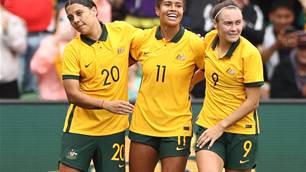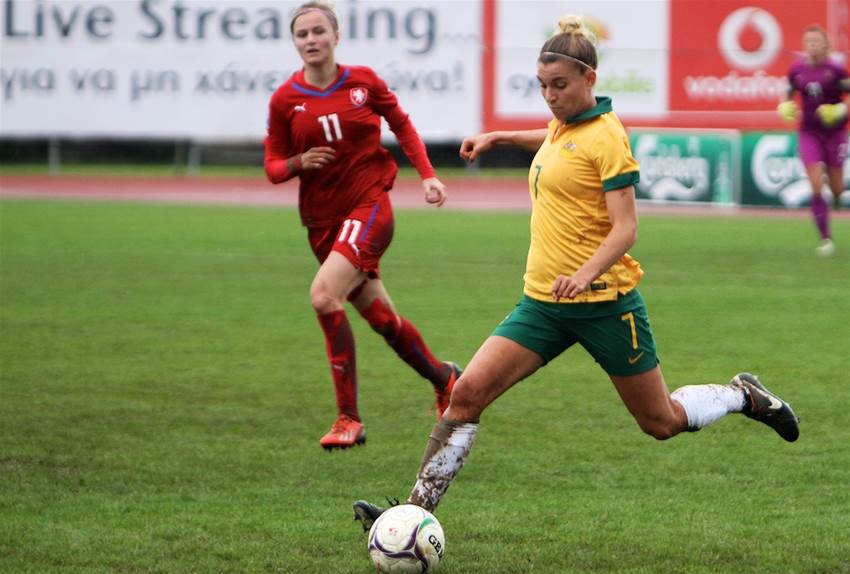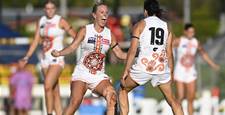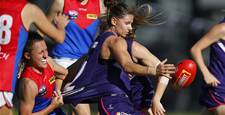This week Australia commences the next phase of World Cup preparations with international friendlies against Austria and Scotland.
This week Australia commences the next phase of World Cup preparations with international friendlies against Austria and Scotland.
The friendlies come at the end of an intensive three week period of training at the Australian Institute of Sport European Training Centre.
The European camp has been utilised by the Matildas coaching staff to continue to strengthen the squad while addressing weaknesses identified during the recent Cyprus Cup.
[More: 2015 Cyprus Cup coverage]
The Cyprus Cup saw Australia finish 5th with three victories over the Netherlands, Finland and the Czech Republic and a loss to eventual champions England.
While the Cyprus Cup was not the first internationals of the year for Australia it our first opportunity to witness the Alen Stajcic revamped team.
Goalkeeping conundrum
At the beginning of 2015, the goalkeeping stocks and options for Australia looked to be competitive and plentiful. By the end of the Cyprus Cup it all looked a little more threadbare.
Lydia Williams (ACL rehab), Casey Dumont (ACL) and Melissa Barbieri (torn hamstring) were out pre-tournament and Brianna Davey had a re-occurrence of a hip injury (obtained during the W-League season) part way through the match against England leaving just Mackenzie Arnold (who carried a slight strain) available.
Williams has returned to training while Davey and Arnold are being nursed leaving the goalkeeping stocks much shakier than 4 months ago.
At top fitness levels, there is little worry for Australia with the Williams and Davey reliable first choice starters (you choose which order) and Barbieri or Arnold capable No. 3s.
The problem is going to be keeping everyone fit and healthy and, as it is already evident, that may just be the hardest part.
Defensive tinkering
The biggest change to the team has been to the defence, both in personnel and positions.
The most noticeable has been the move of left back Stephanie Catley to left centre back.
Catley has been playing in the position since the first training camp in January and currently has 6 internationals under her belt.
That she looks a natural at centre back speaks to her ability as a footballer, although on one or two instances she was caught out positionally with her speed allowing her to prevent any significant damage occurring.
Alongside Catley is Elise Kellond-Knight returning to her 2011 position of left back.
Kellond-Knight had ceded that spot to Catley by virtue of a 12 month ACL rehab in 2011/12.
With Catley gaining acclaim at left back, Kellond-Knight was moved to become a holding midfielder. Her move back occurred in the recent W-League season and, as noted at the time, Kellond-Knight is arguably one of the world’s best in that position.
Right back also saw new personnel with the Asian Cup option of Teigen Allen left at home, Servet Uzunlar gained the starting position to complement Clare Polkinghorne on the right side.
“Just to have two left footers there gives us so much better balance and being able to play out so much more comfortably,” said Stajcic of the changes.
“We really need to get these left footers in the team to give a bit more balance rather than having right footers on the left side.”
The back four of Uzunlar, Polkinghorne, Catley and Kellond-Knight was the Australia’s most stable and balanced combination during the tournament.
They were defensively solid, compact and, thanks to all being quick, difficult to get in behind leaving opposition to long-range efforts.
On the attacking front all are comfortable on the ball, while the full backs pushed on to provide numbers in attack.
This combination dealt the best with Australia’s Achilles’s heel during the tournament; defending counter attacks.
With Australia controlling possession in the four matches, defending on the counter was always going to be a key. While 3 opponents didn’t have the ability to transition quickly enough to hurt the Matildas, England did.
Admittedly Jodie Taylor finished superbly but time and again Australia’s other defensive combinations were opened up too easily once the midfield lost the ball.
“We were probably a little bit naive,” said Stajcic on that night.
“We have to learn how to play against the direct counter-attacking teams like England.”
“There is certainly a lot to work on with our shape and decision making and our defensive structures as well.”
With Australia looking to dominate possession at theWorld Cup and two, possibly three, of their opponents playing pre-dominantly direct football, fixing this gap is paramount.
Midfield challenge
The match against England also asked questions of the Australian midfield.
Australia, as they have for the past four years, set up in the 4-3-3 formation.
As he has in the W-League with Sydney FC, Stajcic employed the attacking incarnation of this formation with Katrina Gorry and Emily van Egmond used as attacking midfielders and Teresa Polias as a defensive midfielder.
Against the lowest ranked opposition (Finland and Czech Republic), they were simply too much for their opposite numbers.
Polias was more than competent in her screening and distribution and Gorry and Van Egmond created scores of chances for the attack.
Netherland and England however posed a different challenge; the first they could solve, the second they were struggled to comfortably overcome.
Despite a slow start Australia, with the Netherlands using a similar formation, were ultimately able to control the midfield and the match as it progressed.
However, England’s more compact 4-4-2 formation proved a more difficult task.
With the numerical advantage and pressing high, England were able to stifle and close off options to the midfield.
The result was a loss of possession in or around Australia's half and numerous counter-attacks in the first half that resulted in goals. The situation wasn’t helped by a lack of execution meaning the supporting full backs were often out of position when the turnover occurred.
Solving the midfield problem is crucial with the United States just this weekend reverting back to a 4-4-2 formation, while it is the standard for Sweden and Nigeria.
The other concern in the midfield was the ability to keep the ball against physical pressure.
Four years ago against Sweden in the quarterfinals of the 2011 World Cup, Australia were physically overpowered by a mature and experienced Sweden.
No more was the gulf evident than in the midfield where the likes of Caroline Seger, Lisa Dahlkvist and Therese Sjögran gained early dominance to feed their strikers.
It can be assured that all three Group D opponents will be put the ball carrier under pressure, either via press or bodily, and the ability to withstand and play through it will go a long way to determining Australia’s success.
“It has always been my philosophy to keep the ball and play out as much as we can.”
“In patches we were good, in other patches we panicked a little bit,” acknowledged Stajcic.
“We know the way we play now and it's a good foundation to build on.”
Forward options
As expected, this was where Australia excellent.
Time and again the forwards were able to get in behind the opposition defence, even in the match against the compact England.
The key factor was Australia’s pace; of foot and ball movement.
It’s safe to say collectively Australia will be the quickest side in Group D across the pitch. With Lisa De Vanna, Sam Kerr, Caitlin Foord, Michelle Heyman, Kyah Simon, Tameka Butt and Ashleigh Sykes, on or off the ball, they will have one of the fastest attacks in the World Cup.
Australia will create chances, plenty of them but once again it will come down to execution as Stajcic noted.
“It was really our decision making and execution in the middle and the front third that let us down at times.”
“However the variety we have in our attack is one of our biggest strengths.”
“We don’t have to reply on just one or two players to score, we’ve got a range of options who all bring something different.”
While De Vanna was the best player for Australia throughout the tournament, Heyman wasn’t far behind with the forward continuing to grow as the central striker.
As was a theme throughout the tournament, all that is missing from her arsenal is consistent execution, meaning goals.
Another theme was the ability for Australia to inject fresh pace into the game late against tiring defences. It is no coincidence that 75% of Australia’s goals in the group stage came in the final third of the game (60th minute or later).
Final observations
As has been the case with Australian sides of late, on the ball the team looks very good with numerous attacking methods and options.
Off the ball is where the work needed to continue, once Australia lost the ball or an attack broke down, the defence was exposed against good attacks. In the World Cup with the likes of Alex Morgan, Christen Press, Lotta Schelin and Asisat Oshoala around, that could spell disaster.
Then again that was almost a month ago and Stajcic and his team have had three solid weeks with the squad to address these and other issues.
Unfortunately whether they have been addressed or not will not be something the public will be able to see for themselves with the continued lack of broadcast of Matildas international matches. We will just have to wait until they return to Australia.
A final note on the squad; while coach Alen Stajcic continues to state that places are still up for grabs for players outside the European camp, it is safe to say a significant majority of the World Cup squad will come from the camp of 27 players.
Confident performances against Austria and Scotland will go a long way to building confidence with just under 2 months left until the Matildas World Cup opener.
Related Articles
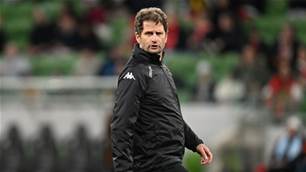
'Timing not right': Montemurro's verdict on Matildas vacancy
.jpg&h=172&w=306&c=1&s=1)
Matildas star ready for epic return after 'really difficult' journey
